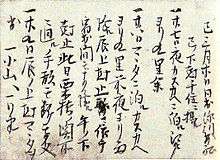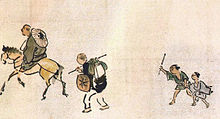Sora's Diary

The Sora Tabi Nikki (曾良旅日記, Sora Tabi Nikki) or Travel Diary of Kawai Sora was the memorandum of Kawai Sora in 1689 and 1691 when he accompanied Matsuo Basho, on his noted journeys.[1] By the time it was re-discovered in 1943, the presence of this diary had been doubted.[2] This diary was indispensable in the study of Oku no Hosomichi by Matsuo Basho.[3]
The Diary
The presence of this diary had been known and it was re-discovered and published by Yasusaburo Yamamoto in 1943. It was designated an Important Cultural Properties of Japan on June 15, 1978. The diary was 11 cm in length, 16.5 cm in width and 2 cm in thickness; the book cover was indigo and the volume contained 100 sheets of paper, including 4 white sheets. There were 11 sheets of paper pasted.[4] It was for convenience divided into summary of divine names of Engishiki, Memorandum of Utamakura, Diary of Genroku 2nd year, Diary of Genroku 4th year, Memorandum of Haiku and Others.[5] Inside the diary, there were no such divisions. The diary was called also Sora Nikki (Sora Diary) and Zuiko Nikki (Diary of Sora accompanying Basho. In the diary, there were no emotional sentences such as seen in Oku no Hosomichi. The names of land visited and the distance between a place to another were exactly recorded.[6] Donald Keene compared this diary to the diary of Francois-Rene de Chateaubriand, namely exactly recording the data of the trip by Julian who accompanied his master.[7][clarification needed] The recording of time in the middle of Edo era in this diary is noted as most exact one.[8][clarification needed] It was shown in Earthly Branches and the time was shown in three divisions.[9] He wrote that while they worshiped at shrines or prayed before shrines, they only visited or saw temples, indicating that he was an earnest Shintoist.[10]
Engishiki Shinmeicho (List of kami)
Engishiki: This was a list of kami by Sora, who studied Shinto under Yoshikawa Koretari (1616–1695) in preparation for their travels. It occupies the beginning of the diary, up to the halfway point of the 12th sheet of paper.[11]
Utamakura Memorandum
In preparation for the trip, he wrote this utamakura memorandum based on the Ruiji Meisho Wakashū and Narayama Shuha. It consumes 8 sheets, starting on the back of the 12th sheet.[12] Findings in the trip were added between the lines. One sheet of paper was pasted. This is also called the "Meisho Memorandum".
Diary of Sora in 1689

Yosa Buson drew an illustration of Oku no hosomichi showing Basho on the horseback accompanied by Sora. This diary was of the trip shown in Buson's illustration. On 33 and a half sheets of paper, it begins with the two leaving Fukagawa in Edo in March during the second year of Genroku, and ends with Sora departed for Ise and Nagashima on August 5. Between these two events, Sore recorded everything in the journey, including the real dates, weather, schedule, and stays in inns. This has become an important document for the study of Oku no Hosomichi. On September 3, Sora rejoined Basho at Ogaki, and the two returned to Fukagawa on November 13. Sora recorded details of the trip.
Diary of Sora in 1691
Sora started on March 4, 1691 and arrived at Nagashima on July 25. This diary is also called the Kinki Area Journey Diary.[13] Starting at the latter half of the 1689 diary, the diary was described for 23 sheets of paper to Haikai Kakidome. Most were on his visits to shrines and temples at Yoshino, Koyasan. Kumano, Wakaura, Suma, Akashi. He recorded the shrines and temples and Utamakura. He visited Basho who was staying at Sagaraku Kakisha, and recorded Basho and his disciples who were editing Sarumino.[14]
Haikai Kakidome
Haikai Kakidome recorded the Hokku (The starting haiku) and haikus of Basho and Sora during their journey and the haiku meetings during their journey. This is an important document in order to know the original form of their haikus.
Zatsuroku(trevia)
On the Japanese archery, Anectodes on Teishitsu which Sora recorded at Yamanaka Spa, Names and addresses of persons Sora and Basho met on their journeys, old haikus; these were jotted down.
History of Diary Prior to Re-discovery
The original book Sora Hon had been present together with a copied Manuscript Okuno Hosomichi in the same box made of paulownia wood.[15] This book was in the hand of Sugiyama Sugikaze who was a close friend of Sora when Sora died in Iki Island, now Nagasaki Prefecture. Shiebo Hakushu, who was a brother-in-law of Sugisha, a son of Sugiyama Sukishu, wrote that Sugifu possessed this book.[16] This book was sent to Koya Family where Sora was born. When the Koya Family ended, this book was under the control of Kasai Family, who was the family of the mother of Sora. Kasai Shutoku, of the Kasai Family, was married with the daughter of one elder sister of Sora. He respected Sora. He edited a book Yukimaruke concerning Sora from various documents of Sora.[17] Later the book went to Kubojima Wakodo.[18] Chikurinsha Shujin of Sendai wrote Wakodo had originally retained the Diary of Sora.[19] Ashiinsha Takesai wrote in his book the map of Sendai in Sora's diary and a line of July 20, 1689 were transcribed at the Wakodo's house.[20] According to a Journal of History of Suwa in 1967, the diary of Sora was illegally taken away from the Kasai Family. Namely Wakodo defrauded the Kasai Family of Sora's diary. Wakodo bought 8 items of Kasai Family including the diary at 58 ryō Tael but paid only 10 ryō. Wakodo was punished by the Takashima han, but the diary was not returned. On the original box, there was a formal letter of transfer of the original Okuno Hosomichi and Sora's diary by the name of Wakodo. Later Matsudaira Shimanokami, one of the daimyo, bought the box. Honma Keishi attested to it. On the Sora's diary, fragments of documents were occasionally seen. For instance, Yokazetei Uko wrote the summary of the Diary from April 21 at Shirakawa to May 9 at Matsushima in Aokage Shu. Asukaen Isso wrote the summary from the start to May 17 at Obanazawa.
Rediscovery of the Diary
In Meiji years, the book was possessed by Kuwahara Shinzo of Osaka, which went to Saito Ikuta of Ito, who had been a famous collector of classical fine arts. It was passed to Saito Hirosuke. Yamamoto Yasusaburo heard of it and with the introduction of Sato Seiiji, he witnessed the airing of summer in 1938.[21] Yamamoto discovered the Diary of Sora among other items of classical fine arts. He published the Diary under the title of the Sora's Diary of Okuno Hoshomichi accompanying Basho, with the 1791 Diary at the Ogawa Shoten in July 1943. Incidentally, this year was the 250th birthday year of Basho's death and the 300th anniversary of the birth of Basho. The second printing was made in December of the same year, and the third printing was in September 1944. The 4th printing was made in 1946. Seiichiro Sugiura visited Hirosuke Saito, the owner living at Uemeguro, with Saburo Miyamoto and examined the Diary on November 5, 1950. Sugiura's original idea was to obtain the Diary in Wataya Bunko of Tenri Library, however, it was not realized. In the course of time, Seiichiro Sugiura had to possess the Diary. He wrote in the first issue of Renga Haikai Kenkyu that this Diary should be studied by researchers and obtained it. After his death, the Diary was presented to the Wataya Bunko of Tenri Library by his wife in February 1959.
Two manuscripts discovered
In 1951, two manuscripts were discovered. One was in the possession of kan-nushi Nasu -Onsen-Jinja, called Giyu Hitomi, and the diary is called Hitomi-Book, and the other is in the possession of Oyamada Family, and the diary is called Oyamada-Book.[22]
Contribution of the diary to the study of Oku no Hosomichi
Previously to the rediscovery of Sora's diary, the studies on Okuno Hosomichi were based on indirect findings[23] After the re-discovery, Sora's diary has become indispensable, for instance, one should read the Haikai Kakidome for the beginning Hokku.[24]
Yamamoto wrote in the beginning of his book that it was a wonder that Sora's Diary had been left in the original shape. It was beyond his expectation. For the previous 250 years, this has been an exceptional discovery even if there have been left an enoumous numbers of books which make an ox sweat in a house. (Idiom)[25]
Shida Gishu was asked to write a preface of Yamamoto's book and wrote that this diary would contribute greatly to the study of Oku no Hosomichi, and every study would contribute to the proof of this diary and attested to the real writings of Sora with various examples of proof.[26] The publication of Sora's diary produced problems of discrepancies between the Basho's Oku no Hosomichi and the Sora's descriptions. Previously to the discovery of the diary, Shida had pointed out that all in the Oku no Hosomichi were not necessarily true and there were examples of fabrications.[27] This problem had been under dispute in 1951 in the Kokubungaku, Kaishaku to Kansho,[28] Toyotaka Komiya supported Basho stating there were no intentional fabrications, but most researchers such as Sugiura, Noichi Imoto, Kisao Abe studied minutely; the academic circle was in favor of the fabrications.[29] Yamamoto's original book contains mistakes and misprintings.[30] Sugiura showed a corrected diary.[31] Thereafter, there have been several books on the corrected Sora's diary.
References
- Ko Higuchi Basho Kenkyu 1923, Bunken Shoin
- Sora Kawai, Yasuzaburo Yamamoto(edit) Giyu Shida Diary of Sora who accompanied Basho with the 1791 Diary 1943, Ogawa Shobo
- Giyu Shida, Basho Tembo(Outlook on Basho 1946, Nihon Hyoronsha
- Sei-ichiro Sugiura, Basho Kenkyu(Studies on Basho) 1958, Iwanami Shoten
- Teizo Shiraishi, The prospect of Okunohosomichi in Basho, 1969, Yuseido
- Riichi Kuriyama, Kokugo Kokubungaku Kenkyu Taisei 12 Basho 1977, Sanseido
- Tomotsugi Muramatsu, Studies on the works and life of Basho, based on new findings 1977, Kasama Shoin, ISBN 4-305-40037-5
- Tetsuo Hisadomi, Okuno Hosomichi, 1980, Kodansha, ISBN 4-06-158452-9
- Yozo Ueno, Basho Ron 1986, Chikuma Shobo,ISBN 4-480-82219-4
- Tomotsugu Muramatsu, Studies on Okuno Hosomichi based on the Sora's Diary 1988, Kasama Shoin, ISBN 4-305-70148-0
- Kishu Okada, Travellers, Sora and Basho 1991, ISBN 4-309-00725-2
- Donald Keene, Travelers of a Hundred Ages (Henry Holt & Co, August 1, 1992) Travelers of a Hundred Ages Kodansha, ISBN 978-4-06-292078-0
Dictionaries
- Tetsuo Ijichi(edit) Encyclopedia of Haikai 1957, Meiji Shoten ISBN 4-625-40005-8
- Yasuaki Matsuo(edit)Encyclopedia of Haiku, Kinsei 1977, Ofusha, ISBN 4-273-00322-8
- Nihon Koten Bungaku Daijiten(Encyclopedia of Japanese Classics) 1986, Iwanami Shoten, ISBN 4-00-080067-1
- Tokuzo Otani(edit), Encyclopedia of Haibungaku 1995, Kadokawa Shoten, ISBN 4-04-022700-X
Notes
- ^ Miyamoto[1986:1125]
- ^ Shida[1943:3-11]
- ^ Matsuo[1977:208]
- ^ Sugiura[1958:185-206]
- ^ Sugiura[1957:426-427]
- ^ Okada[1991:107]
- ^ Donald Keen[2011:494-496]
- ^ Toyama City Museum
- ^ According to Toyama City Science Museum, the use of time by Sora was exactly at the time of Sora.
- ^ Okada[1991:35-38]
- ^ Sugiura[1958:185-206]
- ^ Sugiura[1958:185-206] Miyamoto{1986:1125]
- ^ Sugiura[1958:185-206]Miyamoto[1986:1125]
- ^ Ueno[1995:515-516]
- ^ Sugiura[1958:112-185]
- ^ Muramatsu[1988:6-10]
- ^ Ueno[1995:515-516]
- ^ Muramatsu[1977:324-326]
- ^ Sugiura[1957:426-427]
- ^ Sugiura[1958:185-206]Sugiura[1957:426-427]
- ^ Shida[1943:3-11]
- ^ Sugiura[1957:426-427]
- ^ Higuchi[1923:130-151]
- ^ Ueno[1995:515-516]
- ^ Yamamoto[1943:12-15]
- ^ Shida[1943:3-11]
- ^ Shida[1946:1-15]
- ^ Kuriyama[1977:69-70]
- ^ Shiraishi[1969:132-140]
- ^ Sugiura[1957:426-427]
- ^ Miyamoto[1986:1125]
